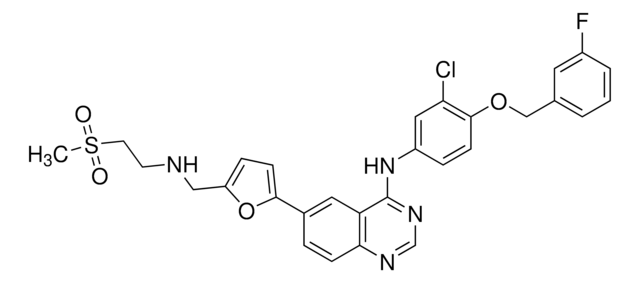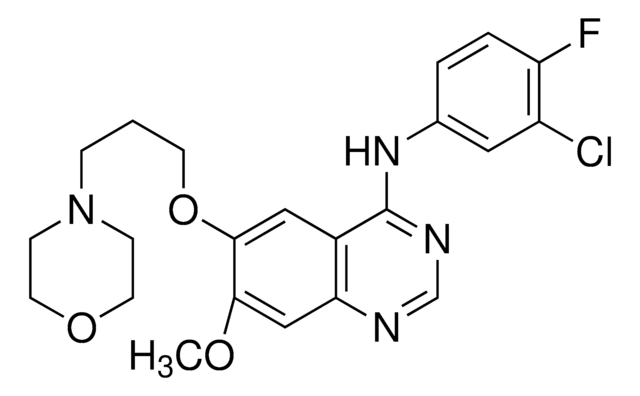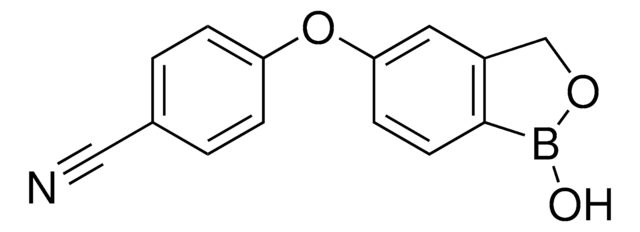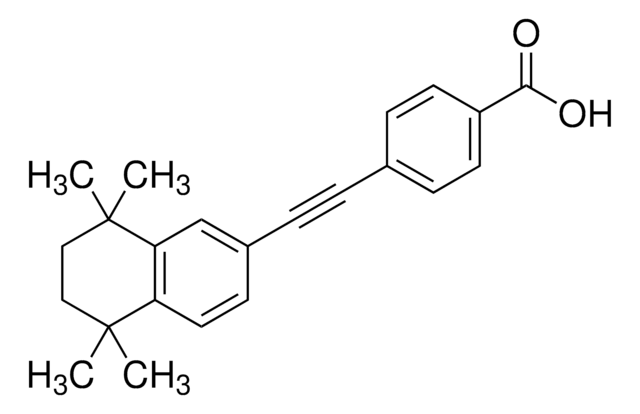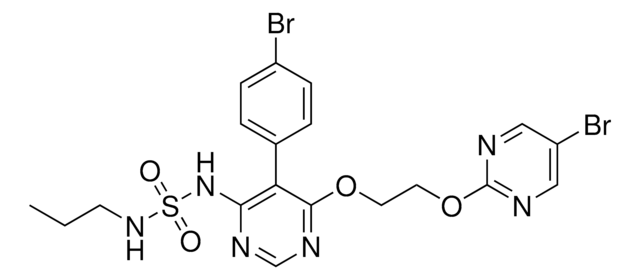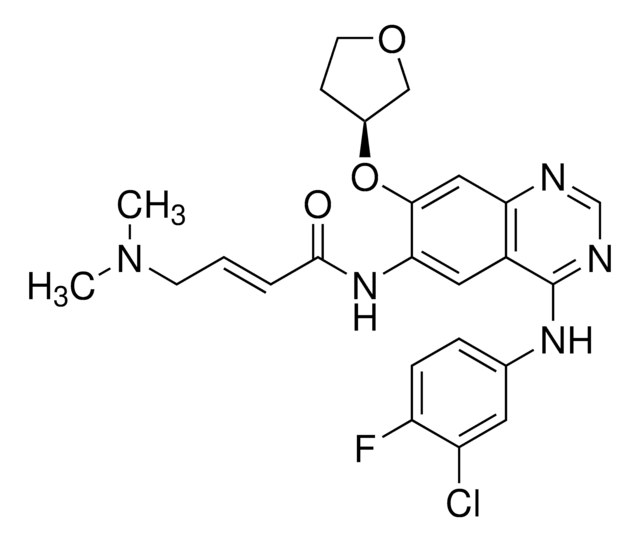추천 제품
Quality Level
분석
≥98% (HPLC)
형태
powder
저장 조건
desiccated
protect from light
색상
white to beige
solubility
DMSO: 5 mg/mL, clear (warmed)
저장 온도
−20°C
InChI
1S/C24H23ClFN5O2/c1-4-33-22-12-20-17(11-21(22)30-23(32)6-5-9-31(2)3)24(15(13-27)14-28-20)29-16-7-8-19(26)18(25)10-16/h5-8,10-12,14H,4,9H2,1-3H3,(H,28,29)(H,30,32)/b6-5+
InChI key
WVUNYSQLFKLYNI-AATRIKPKSA-N
생화학적/생리학적 작용
Pelitinib (EKB-569) is an orally active, potent, second generation irreversible epidermal growth factor receptor tyrosine kinase (EGFR TK) inhibitor. Pelitinib is selective for EGFR (ErbB-1) with an IC50 about 80 nM, but also covalently binds to ErbB-2 (HER2/c-neu) and ErbB-4 (Her 4) with much lower potency. Pelitinib has been shown to inhibit the growth of EGFR-overexpressing tumor cell lines.
Pelitinib specifically targets cancer cells with elevated expression of the efflux transporters ATP-binding cassette (ABC)B1/ABCG2 post hyperthermia. This property of peltinib aids in the elimination of metastasis and prevention of cancer recurrence.
기타 정보
Light sensitive
신호어
Danger
유해 및 위험 성명서
Hazard Classifications
Acute Tox. 3 Oral
Storage Class Code
6.1C - Combustible acute toxic Cat.3 / toxic compounds or compounds which causing chronic effects
WGK
WGK 3
Flash Point (°F)
Not applicable
Flash Point (°C)
Not applicable
시험 성적서(COA)
제품의 로트/배치 번호를 입력하여 시험 성적서(COA)을 검색하십시오. 로트 및 배치 번호는 제품 라벨에 있는 ‘로트’ 또는 ‘배치’라는 용어 뒤에서 찾을 수 있습니다.
Shan Bian et al.
Nature methods, 15(8), 631-639 (2018-07-25)
Brain tumors are among the most lethal and devastating cancers. Their study is limited by genetic heterogeneity and the incompleteness of available laboratory models. Three-dimensional organoid culture models offer innovative possibilities for the modeling of human disease. Here we establish
Molly F Kulesz-Martin et al.
Cancer biology & therapy, 14(2), 95-99 (2012-11-30)
Current therapies for Renal Cell Carcinoma favor vascular endothelial growth factor receptor (VEGF-R) tyrosine kinase (TK) inhibitors (TKIs). In theory, these are most applicable in tumors that have lost VHL-with subsequent stabilization of HIF and upregulation of VEGF. A subset
Yeong Hoon Kim et al.
The Korean journal of parasitology, 55(5), 491-503 (2017-11-07)
The effects of tyrosine kinase inhibitors (TKIs) were evaluated on growth inhibition of intracellular Toxoplasma gondii in host ARPE-19 cells. The number of tachyzoites per parasitophorous vacuolar membrane (PVM) was counted after treatment with TKIs. T. gondii protein expression was
Kenneth K W To et al.
British journal of pharmacology, 172(16), 4089-4106 (2015-05-20)
Pelitinib is a potent irreversible EGFR TK inhibitor currently in clinical trials for the treatment of lung cancer. Hyperthermia has been applied concomitantly with chemotherapy and radiotherapy to enhance treatment outcome. In this study, we investigated the ability of the
Jean-Philippe Coppé et al.
Nature cell biology, 21(6), 778-790 (2019-06-05)
Phosphorylation networks intimately regulate mechanisms of response to therapies. Mapping the phospho-catalytic profile of kinases in cells or tissues remains a challenge. Here, we introduce a practical high-throughput system to measure the enzymatic activity of kinases using biological peptide targets
자사의 과학자팀은 생명 과학, 재료 과학, 화학 합성, 크로마토그래피, 분석 및 기타 많은 영역을 포함한 모든 과학 분야에 경험이 있습니다..
고객지원팀으로 연락바랍니다.


